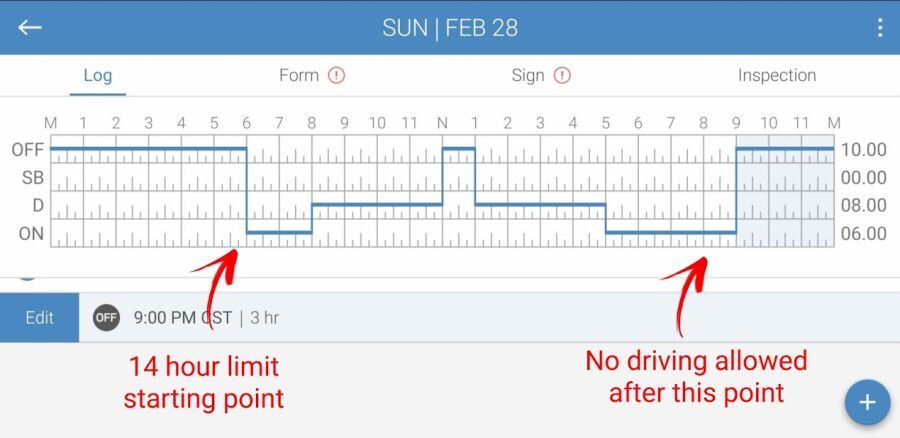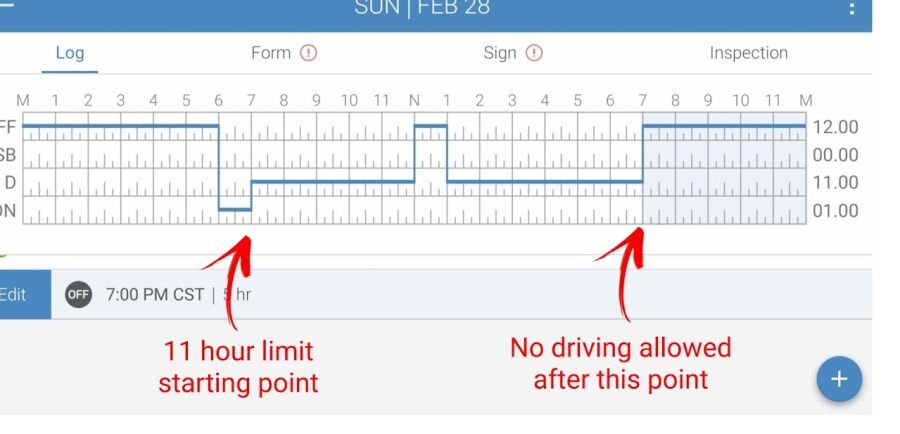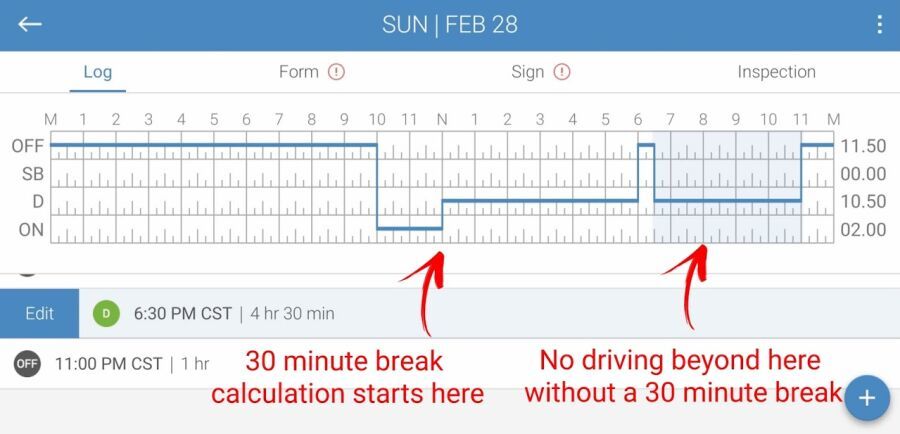Hours Of Service Rules
Topic 30948 | Page 1
Here goes, the condensed version:
Once you start your clock at the beginning of a shift, your 14 starts ticking. Once you're 14 starts ticking down, it doesn't stop (except for a couple other circumstances which we'll skip for now to lessen confusion).
So now you've started your clock. Within those 14 hours you're allowed up to a maximum of 11 hours of driving. That's it. Once the 14 has ticked down to zero, you must stop driving. That's when you take the required 10-hour break, which resets your 14 and 11 clocks. Then you start a whole new shift.
There are other nuances and circumstances that come into play to change things around, but that's the nuts and bolts of it.
I don't have much time at the moment, but someone will certainly be around to explain further.
Check out the Hours of Service section in the High Road CDL Training Program for a detailed tutorial in all of the HOS rules.
CDL:
Commercial Driver's License (CDL)
A CDL is required to drive any of the following vehicles:
- Any combination of vehicles with a gross combined weight rating (GCWR) of 26,001 or more pounds, providing the gross vehicle weight rating (GVWR) of the vehicle being towed is in excess of 10,000 pounds.
- Any single vehicle with a GVWR of 26,001 or more pounds, or any such vehicle towing another not in excess of 10,000 pounds.
- Any vehicle, regardless of size, designed to transport 16 or more persons, including the driver.
- Any vehicle required by federal regulations to be placarded while transporting hazardous materials.
HOS:
Hours Of Service
HOS refers to the logbook hours of service regulations.
Thanks for that explanation Turtle!
Hey Brian, the hours is very confusing at first, but you are misunderstanding some of it right now. Don't worry about that, it is a common struggle for all of us at the beginning.
Here's the main part to remember for now. Once you first go on duty and start your clock you have a 14 hour window of time that you are allowed to drive within. You could start your day and do a twenty five minute inspection of your equipment and then start driving for two hours. If you felt a little tired you could stop and take a break for an hour or so if you wanted. Then you could start again. You don't have to drive 11 hours each shift. You might just drive six hours one day and be done with everything you needed to accomplish for that day.
Let's say you started your day and worked one hour on duty getting loaded, and then you started driving and drove four hours to your delivery point. They take two hours to unload you and you decided to put yourself on off duty for 1.5 hours of that time since you were just sitting in the truck waiting on them. You don't have another load assignment so you drive thirty minutes to a truck stop for a ten hour break. Your logs will show that your 14 hour clock only used a total of 7.5 hours for that shift. Your 11 hour clock will show that you drove for 4.5 hours of that shift. You show 1.5 hours of "on duty time, and 1.5 hours of off duty time for that same shift. Does that make sense?
If not, try looking at this stuff and see if it helps. This is from our revised section on hours in our High Road CDL Training Program.
There are three limits and one break requirement which must be followed at all times. They are:
- The 14-hour, on-duty limit
- The 11-hour-driving limit
- The 30-minute break
- The 60/70-hour, on-duty limit
THE 14-HOUR, ON-DUTY LIMIT
This limit is usually thought of as a daily limit, even though it is not based on a 24-hour period. You are allowed a period of 14 consecutive hours of on-duty time after being off duty for 10 or more consecutive hours. The 14-consecutive-hour, on-duty period begins when you start any kind of reportable work (doing your pre-trip inspection , performing vehicle maintenance, loading / unloading cargo, fueling, driving, etc.). Once you have reached the end of this 14-consecutive-hour period, you cannot drive again until you have been off duty for another 10 consecutive hours.
Your opportunity for driving is limited to the 14 consecutive hours from the time you started your day. You can take care of other on-duty tasks beyond the 14-hour limit, but you must limit your driving time to this 14-hour window. This is a rule which has a few exceptions. There are some ways to extend this 14-hour period, but we will get into that later. For now, just think of it as an important limit. We are going to tackle this in little bites. We need to learn each of these rules as they are introduced to us. As we master them we will begin to learn more about them as we progress through this study material.
14-HOUR ON-DUTY LIMIT EXAMPLE:

The above image is an example of a driver's daily log. Let's try to further understand the 14-hour on-duty limit using this example.
You began working at 6:00 a.m. (vehicle inspection, fueling, loading / unloading freight, etc.). That makes 6:00 a.m. your starting calculation point for the 14-hour, on-duty limit. You must not drive your truck after 8:00 p.m. that evening (14 hours later). You may do other work after 8:00 p.m. (load / unload freight, perform maintenance duties, etc.), but you cannot do any more driving until you have taken 10 consecutive hours off duty. Once you have taken 10 consecutive hours off duty, your 14-hour limit will start over as soon as you go back on duty.
11-HOUR DRIVING LIMIT
During the 14-consecutive-hour, on-duty period, you are only allowed to drive your truck for up to 11 total hours. Once you have driven a total of 11 hours, you have reached the driving limit and must be off duty for another 10 consecutive hours before driving your truck again. You can think of this as a window of opportunity. You have a 14-hour window of opportunity, in which you can drive your truck for 11 hours. This 11-hour driving limit is also reset when you take your 10-hour break. Both the 14-hour clock and the 11-hour clock are fully reset after logging 10 hours off duty.
11-HOUR DRIVING LIMIT EXAMPLE:

After taking 10 consecutive hours off, you begin work at 6:00 a.m. and drive from 7:00 a.m. until 7:00 p.m. with a one hour break from noon to 1:00 p.m. (total of 11 hours driving). You cannot drive again until you have accumulated at least 10 consecutive hours off duty. You may do other work after 7:00 p.m., but you cannot do any more driving of a CMV.
Continued...
Pre-trip Inspection:
A pre-trip inspection is a thorough inspection of the truck completed before driving for the first time each day.
Federal and state laws require that drivers inspect their vehicles. Federal and state inspectors also may inspect your vehicles. If they judge a vehicle to be unsafe, they will put it “out of service” until it is repaired.
CDL:
Commercial Driver's License (CDL)
A CDL is required to drive any of the following vehicles:
- Any combination of vehicles with a gross combined weight rating (GCWR) of 26,001 or more pounds, providing the gross vehicle weight rating (GVWR) of the vehicle being towed is in excess of 10,000 pounds.
- Any single vehicle with a GVWR of 26,001 or more pounds, or any such vehicle towing another not in excess of 10,000 pounds.
- Any vehicle, regardless of size, designed to transport 16 or more persons, including the driver.
- Any vehicle required by federal regulations to be placarded while transporting hazardous materials.
CMV:
Commercial Motor Vehicle
A CMV is a vehicle that is used as part of a business, is involved in interstate commerce, and may fit any of these descriptions:
- Weighs 10,001 pounds or more
- Has a gross vehicle weight rating or gross combination weight rating of 10,001 pounds or more
- Is designed or used to transport 16 or more passengers (including the driver) not for compensation
- Is designed or used to transport 9 or more passengers (including the driver) for compensation
- Is transporting hazardous materials in a quantity requiring placards
30-MINUTE BREAK RULE
There are times when you will be required to take a 30-minute break. If you drive 8 consecutive hours with no breaks, you are not allowed to drive a CMV until a 30-minute break is taken. You may perform other on-duty tasks but you cannot drive. The 30-minute break can be taken as an off-duty break or it can also be satisfied during a time period of performing on-duty tasks. It can also be taken as a combination of on-duty and off-duty time. It could also be satisfied in the sleeper berth. Any combination of the three could suffice for a legal break. You could take 15 minutes on duty time fueling, then another 15 minutes off duty to run into the truck stop to relieve your bladder and purchase a snack and a drink. That would legally suffice for your 30-minute break.
If you take some on-duty time at the beginning of your shift it does not count against your eight hours drive time. You could start your day at 4:00 a.m. getting your truck loaded, and not start driving until 8:00 a.m. If that is the case you can drive for up to 8 hours (or until 4:00 p.m.) before being required to stop and take your 30-minute break. Of course, you can take it earlier if you choose. This is just an example to help you understand the structure of the rule. You simply are not allowed more than 8 hours of driving without taking a 30-minute break. Here is an example of the 30-minute break provision:

In the above example, the driver first went on duty at 10:00 a.m. That is not the starting point of his calculation for his 30-minute break. He started driving at noon. That becomes the starting point for calculating when he needs to take his 30-minute break. If the driver doesn’t stop for the next 8 hours he must take at least a 30-minute break by 8:00 p.m. (8 hours later) in order to continue driving a CMV. If a break is not completed by 8:00 p.m., no driving can legally be done. The driver can perform other on-duty tasks, but cannot drive. In this example, however, a 30-minute, off-duty break was taken from 6:00 p.m. to 6:30 p.m. so the driver was legally allowed to continue driving.
That's just the basics to get you started thinking correctly about how it works.
I hope that helps a little.
Sleeper Berth:
The portion of the tractor behind the seats which acts as the "living space" for the driver. It generally contains a bed (or bunk beds), cabinets, lights, temperature control knobs, and 12 volt plugs for power.
CMV:
Commercial Motor Vehicle
A CMV is a vehicle that is used as part of a business, is involved in interstate commerce, and may fit any of these descriptions:
- Weighs 10,001 pounds or more
- Has a gross vehicle weight rating or gross combination weight rating of 10,001 pounds or more
- Is designed or used to transport 16 or more passengers (including the driver) not for compensation
- Is designed or used to transport 9 or more passengers (including the driver) for compensation
- Is transporting hazardous materials in a quantity requiring placards
OOS:
When a violation by either a driver or company is confirmed, an out-of-service order removes either the driver or the vehicle from the roadway until the violation is corrected.
Don’t forget that 30 minutes of on duty time now counts as a 30 minute break.
After a short time of training, HOS regulations are fairly easy to understand, so don’t fret too much. Just remember that the 11 hr, 14 hour and 70 hr limits are the most you can do. A driver is not required to drive/work until these limits are met. You get tired, pull into a safe place and rest. It’s that simple. In fact, it’s rare that a driver will use up all his clock. Why? Because You have to leave some time to find parking, do your post trip, update your EDL, all that should be done On Duty after you have parked. Then you log into sleeper berth and get some much deserved rest. Not too strenuous, I’m 69 and I get plenty of rest.
Sleeper Berth:
The portion of the tractor behind the seats which acts as the "living space" for the driver. It generally contains a bed (or bunk beds), cabinets, lights, temperature control knobs, and 12 volt plugs for power.
HOS:
Hours Of Service
HOS refers to the logbook hours of service regulations.
Thanks everyone who has replied! I really appreciate the help and the insights! Bruce, thanks for that as I'm going to be 65 when I transition over to trucking.
New Reply:
New! Check out our help videos for a better understanding of our forum features

















Preview:








 TT On Facebook
TT On Facebook
Attempted to read the FMCSA CDL document regarding driver's hours and got a headache. Could someone please give me a plain English, for dummies, explanation of how driver hours are defined. I get that you can drive for 11 hours out of 14 hours then you get 10 hours of rest. But is sounds like this really isn't the case. Can you start and stop your times or is it once you start on-duty you can't stop until you clock in 11 hours. From what I've seen and heard drivers aren't getting a ton of rest so how does that work? Sorry for all the questions from a potential newbie nugget but just wanting to find out all the facts before I decide on making the jump.
CDL:
Commercial Driver's License (CDL)
A CDL is required to drive any of the following vehicles:
CSA:
Compliance, Safety, Accountability (CSA)
The CSA is a Federal Motor Carrier Safety Administration (FMCSA) initiative to improve large truck and bus safety and ultimately reduce crashes, injuries, and fatalities that are related to commercial motor vehicle
FMCSA:
Federal Motor Carrier Safety Administration
The FMCSA was established within the Department of Transportation on January 1, 2000. Their primary mission is to prevent commercial motor vehicle-related fatalities and injuries.
What Does The FMCSA Do?
Fm:
Dispatcher, Fleet Manager, Driver Manager
The primary person a driver communicates with at his/her company. A dispatcher can play many roles, depending on the company's structure. Dispatchers may assign freight, file requests for home time, relay messages between the driver and management, inform customer service of any delays, change appointment times, and report information to the load planners.DAC:
Drive-A-Check Report
A truck drivers DAC report will contain detailed information about their job history of the last 10 years as a CDL driver (as required by the DOT).
It may also contain your criminal history, drug test results, DOT infractions and accident history. The program is strictly voluntary from a company standpoint, but most of the medium-to-large carriers will participate.
Most trucking companies use DAC reports as part of their hiring and background check process. It is extremely important that drivers verify that the information contained in it is correct, and have it fixed if it's not.